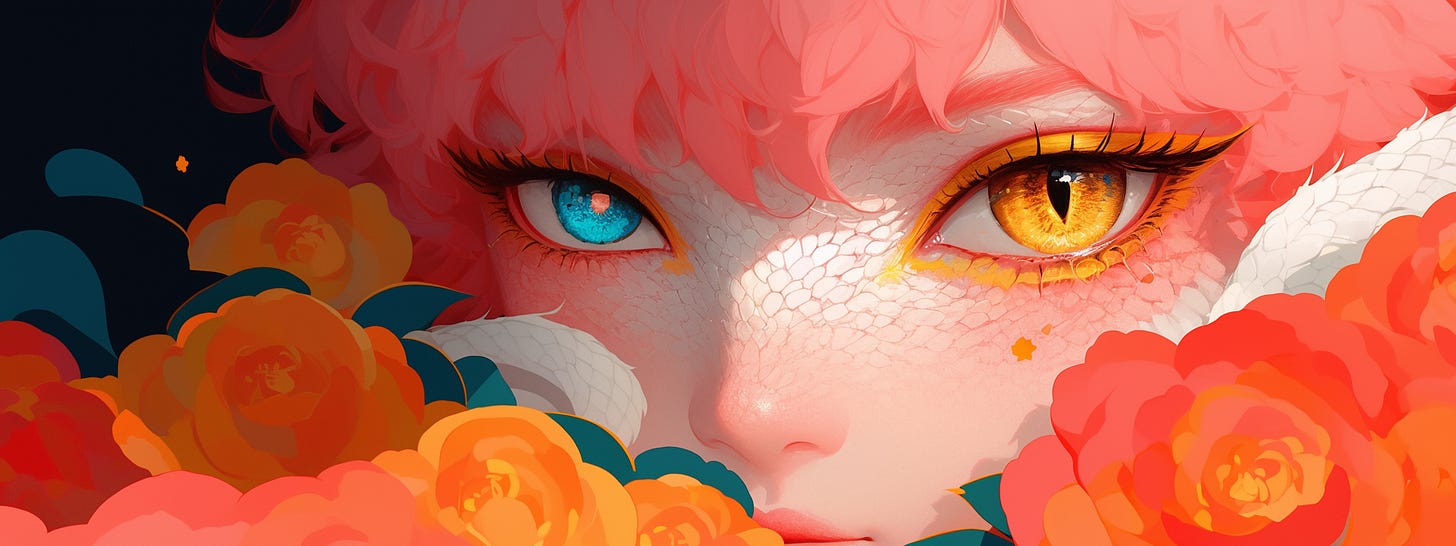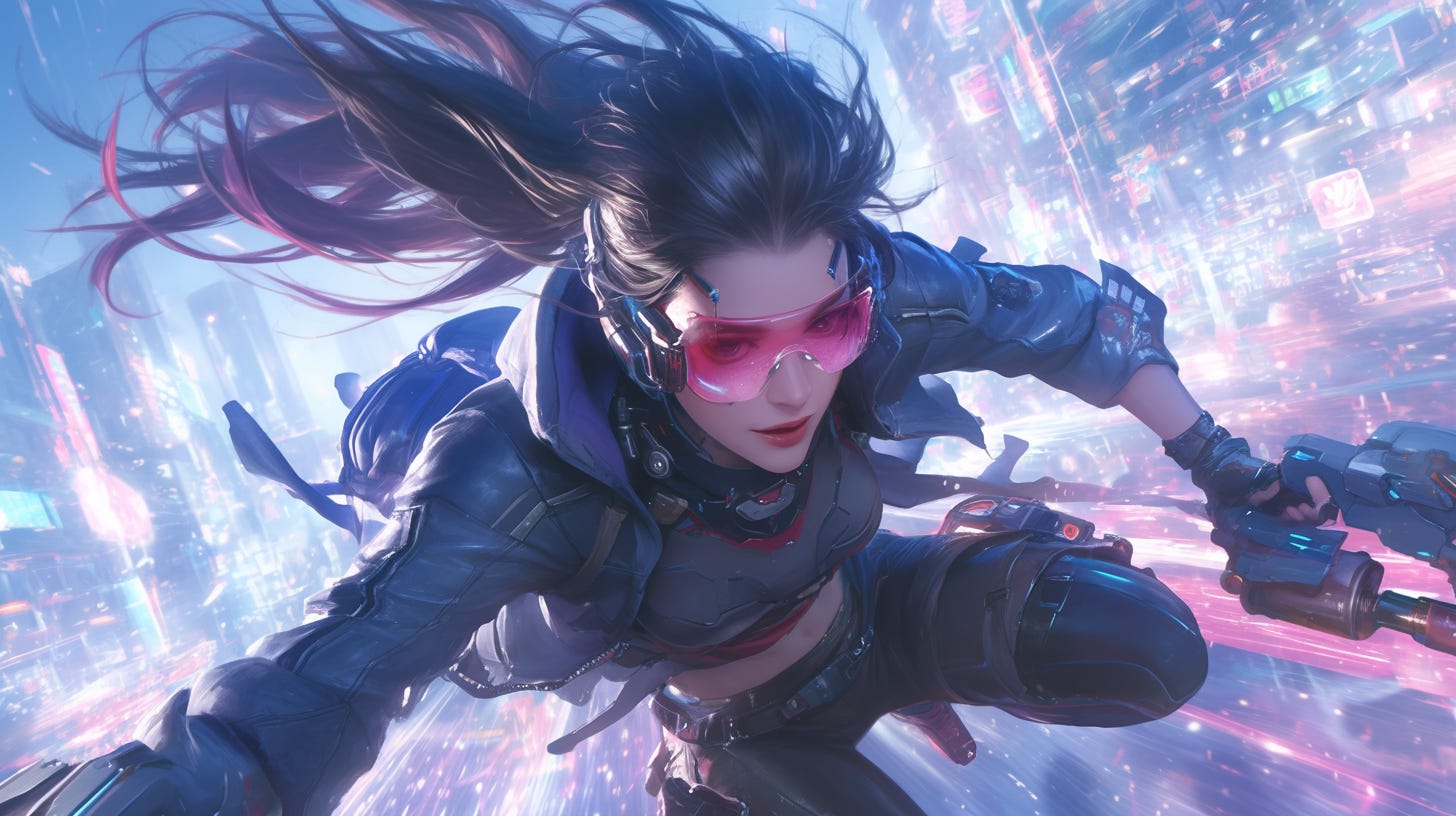Beginner's Guide to AI: The Art of Prompting
How I refined my Prompt structure to consistently create amazing AI Art
The appeal of generative art lies in its simplicity. You can prompt something like "Beautiful cyberpunk woman" and instantly get a stunning result.
No special skills, advanced hand-eye coordination, or technical expertise required.
But... that novelty wears off quickly.
So, how do you go from being a generative AI newbie to becoming a skilled AI artist?
This is where prompt guides come in.
Why? Generative AI is driven by natural language, right? You just tell it what you want—so why bother with what others are doing?
Well, there are a few reasons:
Not everyone has an artistic background.
Some people simply think differently and come up with brilliant ideas.
Let’s dive a bit deeper into this.
Prompting is a new and evolving art form. It's impossible to cover everything in detail in one article, which is why I write my newsletter—to keep learning and sharing those lessons with my readers.
However, this article aims to give you a strong foundation. I’ll do my best to make it as comprehensive as possible.
So, what makes a great image?
There are four key components:
The subject
The story it tells or the emotion it conveys
The technique used to express that
The composition
Sounds complex? Stick with me.
The biggest mistake people make when generating images is focusing solely on the subject and its attributes, without considering the other three elements. Prompts like “Beautiful cyberpunk woman”, “A cat with a hat”, or “A dragon with big wings, breathing fire” are very common and often produce visually impressive images—but they get old fast.
Everyone can create these now, so why would anyone want to keep looking at them?
Without emotional content or a story behind the image, these creations lack meaning—and thus, aren’t interesting.
To create great images, don’t just think in terms of the subject, whether it’s women or dragons. The most important part is the emotion and the story your image tells. Focus on the feelings you want to convey, and you're more likely to create something truly captivating.
Let’s start with something simple:
Technique
We’ll begin by choosing a technique. It could be photography, illustration… but let’s go with digital art for now.
Here's an important point: each of these terms—whether it’s photography or illustration—represents an entire style with a rich description, yet it’s just a single word in the prompt. Generative AI tools are familiar with these words and can produce excellent images based on them.
Techniques act as keywords that evoke specific effects in your image: watercolor, bokeh, ink, line art, chiaroscuro, collage…
Try to learn the meaning of as many of these terms as you can.
Subject and Emotion/Story
Now, let’s add more detail to our “beautiful cyberpunk woman”:
By adding “confident” we immediately infuse emotion into the scene.
Next, we can build on that attitude by adding “long flowing hair” and “futuristic glasses.”
Finally, we introduce a bit of story: “running from a huge illuminated starship behind her.”
Now, our prompt has two more essential components: a subject and an emotion/story.
Here’s the updated prompt:
“Digital art of a confident cyberpunk woman with futuristic glasses and gear, long flowing hair, running from a huge illuminated starship behind her.”
Composition
Generative AI's default image format is square—a shape that might be mathematically convenient for programmers and scientists but is often unappealing from an artistic perspective.
If you want to create great images, avoid square formats unless you're designing logos, fabric patterns, or stickers. For most other purposes, a rectangular format is much more effective.
About natural language
It’s not entirely accurate to say that generative AI uses natural language to create images. AI tools don’t care about the stylistics of your sentences, but they do care a lot about the specific words you choose.
Generative AI extracts keywords from the sentences you provide and uses those to compute the image. The quality of the resulting image depends heavily on the quality of those keywords.
Beautifully constructed sentences won’t produce better images. What matters are carefully selected words that clearly express your intent.
For example, “tiny” works better than “small,” and “huge” is stronger than “big.” Words like “alluring,” “gorgeous,” or “elegant” are much more specific and impactful than simply saying “beautiful.”
Most verbs in your sentence—especially transitive ones like “conveying,” “enhancing,” or “portraying”—won’t influence the image at all and are a waste of space and time.
The prompt structure that works
The best prompts have no decorative, meaningless words and a simple structure.
As I have said before, the sentence structure does not really matter for Midjourney, but it helps to have one for easy prompt management and modification.
My preferred structure is this:
[type of image], [subject], [subject attributes and/or activity], [environment or background], [techniques], [parameters]
I use this structure in nearly all of my prompts. It is easy to work with, modify, and adapt to new tasks.
So let’s get into some detail on how to fill in this template.
1. Type of image
Photography
Types: Landscape, Panoramic, Portrait, Fashion, Abstract, Black and white, etc.
Illustration
Types: Abstract, Cartoon, 3D, Minimalistic, Infographics, etc.
Painting
Types: Oil, Watercolor, Pastel, Charcoal, Pencil drawing, Ink, etc.
Poster
Types: Vector graphics, Vintage, Movie, Pop-art, Typography, etc.
2. Subject
At first glance, the subject might seem like the easiest part of the prompt, requiring little special thought.
But here’s the thing: you need unique and interesting subjects to grab attention and make people stop.
If you want your creations to stand out, the subject must be engaging enough to do so. This is where your creativity shines.
3. Subject Attributes and Activity
Once you’ve selected your subject, it’s time to add attributes—details that help tell the story and bring the subject to life.
This is where adjectives and descriptors come into play. Finding the right words to describe your subject is key to achieving the desired result.
Each time you create a prompt, look for ways to refine it with better, more precise, or more exaggerated adjectives and descriptors. This will significantly improve your results.
4. Environment and Background
The background and environment are where you complete your storytelling. This is where you set the atmosphere and mood of the image, shaping the story you want to tell.
At a basic level, a dark background creates a sense of drama, contrast, and conflict, while a bright background sets a light, joyful mood. There are many subtleties to consider, but understanding this simple dark vs. bright background concept is a solid foundation.
Next comes color, which is crucial in setting the mood and atmosphere of the image. Learn how to use color intentionally. A blue-toned world evokes a different feeling than a red one. Is it dawn or dusk? Are you depicting a cityscape or a barren wasteland?
The background offers many ways to shape mood and atmosphere. For instance, towering rocky mountains will create a vastly different feeling than soft sunset clouds or blooming bushes. The key takeaway is that the background and environment are vital elements in creating compelling images with generative AI.
5. Techniques
Artists and photographers use thousands of different techniques, and even describing them all in a book would be a challenge—let alone in one article.
The good news is that to get started, you only need to learn a few basic techniques to help AI tools generate better images. You can gradually expand your knowledge over time.
If you're working with photography-style images, for example, mentioning "wide-angle lens" for landscapes or "macro close-up" for detailed, small subjects can make a big difference. Using terms like "high-contrast photography" or "fashion photography" signals to the AI that you're aiming for a more polished, professional look, rather than something amateurish.
These terms also help with composition, color management, and other technical aspects, as they inherently incorporate elements of high-end photography.
6. Parameters
I use the principles described in this article for most of the images I create with Midjourney, Flux, Mystic, and Leonardo. These principles generally apply across different AI tools.
However, it’s important to learn the specific parameters for each tool, as they all offer unique styles that might overlap with your prompt descriptions. I’ll be covering these in more detail in the newsletter as we continue exploring them together.
Aspect Ratio
Aspect ratio matters. I recommend using a 2:1 ratio for most of your images; these proportions tend to result in better composition and work well in articles. Just to emphasize: whatever ratio you choose, avoid square images (unless you're posting on Instagram—then feel free to ignore this advice).
Image Reference
Some tools offer an image reference feature, allowing you to use images you like as part of the input for generating new content. Reference images can help influence the composition, color palette, or overall mood of the AI-generated image.
Conclusion
I’m constantly on the lookout for new prompts, reading articles, and following people who share their ideas. I learn new styles, perspectives, and techniques, then adapt them to the structure outlined here.
And it’s fun!
I hope this article was helpful and informative. I wish you the best of luck and plenty of inspiration as you work toward mastering generative AI.











